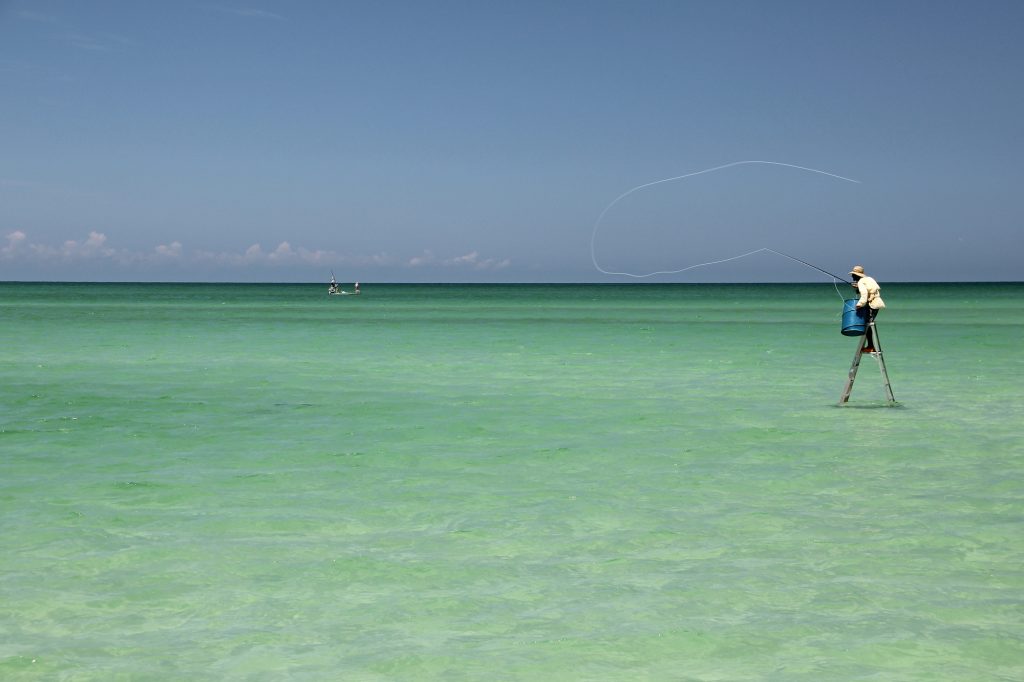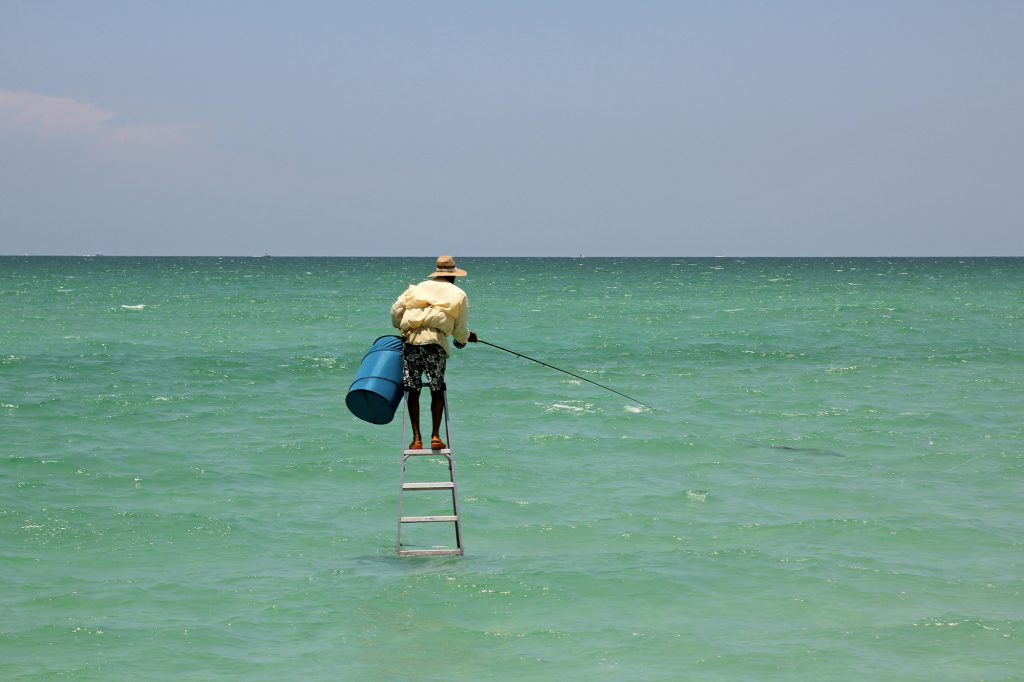July 18, 2016
By Florida Sportsman
Fly fishing for summer tarpon from a unique perspective.
Story by Mike Cosentino, Photos by Cavin Brothers
Originally Published June 2011.
 Amid the emerald shoals, Cosentino unfurls a cast to wary tarpon, while anglers in distance search for fish.
Amid the emerald shoals, Cosentino unfurls a cast to wary tarpon, while anglers in distance search for fish.
Are there any Gulf Coast fly fishers out there who want to enjoy some Keys-style sight fishing for tarpon without leaving home? It's easier than you think. Just grab your step-ladder and head for the shoal outside your nearest pass.
While I'd seen tarpon on the clear shallow flats of our pass shoals for years, I'd never taken the time to figure out how to target them, opting to fish the schools migrating down the coast. Several years ago, however, I decided it was time to pay my dues and to figure out how to target these shallow water fish.
I began my search by pushpoling the shoals. And while I could find the fish, their cruising speed proved too fast for interception. I spent considerable time watching their routes as they traversed the shallows. And whether a bar point, trough or dropoff, I found several places at which a good percentage of the fish seemed to swim within casting range.
My next move was to anchor on these spots and wait for the fish to come to me. And while they did, in all but the calmest conditions the hull slap of my flats skiff kept them just outside of fly-casting range. Amidst my mounting frustration I remembered seeing some fly fishermen sight fishing for mangrove-cruising snook from step-ladders in Charlotte Harbor many years back. Ah-ha!
The next day I was back, with ladder. My sun break under the Bimini was interrupted by a wild holler from my friend Zeke. He had a 100-plus pound tarpon tail-walking away from him.
From Captiva Pass to Anna Maria Island, there are shoals outside the passes built up by the ebb tide sedimentation and by the blockage of the southerly drift of eroded coastal sand. While the tarpon migrate up and down the coast, they also move into and out of our bays. And though some use the channels, many use the shoals as their crossing route to and from the bays. The shoals are where we're headed.
The best way to ensure consistent action is to spend some time looking for those spots which seem to funnel the tarpon into casting range. Surveying a shoal at extreme low tide is helpful for locating prospective spots such as bar points, dropoffs and finger channels, all of which, at times, seem to concentrate the fish. It's worthy of mention that each summer the shoals, and my spots, change considerably. Even so, the tarpon will be found near the same type of topography as in years past, so it pays to note the conditions prevalent where you locate the fish.
Here's how I set up. I open my ladder on the forward deck of my skiff and stand it up into the water, the depth of which is about four feet. I then anchor the boat a couple casts away, hopefully such that it will push approaching fish toward, not away, from me. I use a garden center collapsible lawn and leaf bag as a stripping basket, into which I put my rod, Crocs (easy on the feet), and dry tote bag filled with camera, phone, snacks and other needs. I then wade to my ladder, secure my things, and start looking. I tie the basket to my waist; the fish may approach from any direction and you have to be able to turn and cast. I use an aluminum Werner 10-foot ladder that has a platform at 8 feet. This is quite stable and comfortable and the platform makes it easy to turn and cast when necessary.
Surely 100-foot casts are nice, but the most important thing is to lead the fish by a good 15 feet or so. They have tremendous eyesight, and they're really spooky in the shallows, so landing closer than that usually sends them quickly away. You must also compensate for current, which can be quite strong at times. Note that when fish are moving at you with the current, even a 2-foot strip is only going to move the fly six inches or so. As the fly lands you must strip as fast as you can to impart any action at all to the fly.
Do what you're comfortable with, but I use only a floating line, regardless of conditions. Inevitably they sometimes zig when I guessed zag. I can pick up and recast the floating line immediately and feel this benefit outweighs any other considerations.
For fish over 60 pounds or so, which is almost all of them, I'm headed for the boat once they're on the reel. Not that you couldn't land a big one from the ladder; I'm just hesitant to chance that tarpon- shark meeting happening at my feet.
I've found it to be both helpful and fun to buddy-up for this game. Not only can you help each other spot fish, it's nice to have someone bring the boat to you amidst the post hookup chaos. Just place your ladders apart such that you can almost cast to a midpoint between them.
It's very hard to spot the tarpon before about 10 a.m. due to the angle of the sun. Similarly, they're hard to spot after 4 p.m. Most days, 10 a.m. until noon is best because the sun is up and the clouds are not. Midday can be great—just be patient and fish during the breaks in the clouds. And avoid those afternoon thunderstorms, obviously!
My favorite tide is none. The tarpon seem to roam more during the slack water and I don't have to fight the current to work the fly. Around the new and full moons, I like the last of the incoming till the ebb gets moving; this usually occurs during midday. Like other fishing, though, the best time to go is when you can.
 Tarpon approaching with the fly in position.
Tarpon approaching with the fly in position.
One of the most significant benefits of the ladder is the comfort it provides. I watch the guys around me being tossed about their skiffs as the sea breeze gets kicking and know they're miserable because it used to be me. I just kind of smile as I wonder why they make it so hard on themselves and their clients. Plus, I've caught many fish from the comfort and stability of my ladder long after the sea breeze swept waves have chased the others away.
While it's simple to strap a ladder or two to the poling platform of a skiff, a nice alternative is a pontoon boat. Not only do they have plenty of room for equipment, it makes for a shady and comfy place to take a break—not to mention the added benefit that other fishermen would likely never suspect you were fly fishing for tarpon!
Speaking of other fishermen, there are plenty of fish and there is plenty of room. So relax, people. Be nice. You'll have more fun. And don't worry about the Jet Ski that just ran over those fish. More will come by soon. And unlike other areas, these fish don't seem as bothered by the traffic. Okay, yes, the guys in the tower boats chasing them around the shoal are spooking them, but the frustration of never hooking one helps them leave on their own. No need to tell them how silly they are.
Finally, a thought or two about fly selection. I now believe choice of fly truly doesn't matter. If they're eating, they'll eat it. If they're not, they won't. So use one you believe in and stick with it. When I tie a fly on it stays on until it catches a fish or gets broken off by one. That said, I tie mostly Deceiver-type patterns of any color with bucktail and feathers on 3/0 Tiemco 600SP hooks. I snell them to 60-pound mono bite tippet early in the season when the water is clear. As the summer rains darken the water I go up to 80-pound. I test-swim the snelled flies—they must swim perfectly or I retie them.
The vast majority of the fish you see won't eat. It doesn't mean you or your fly is wrong. Be patient and keep trying. When you do get one it will be the most memorable fish of your life. Good luck and have fun!
FS

